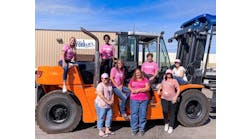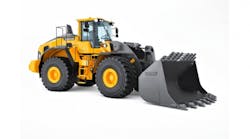Witness any area of destruction, whether caused by natural or manmade forces, days after an event and you are guaranteed to see construction equipment of one type or another. For as much as construction equipment is used for its intended and literal purpose — to construct — it is equally as important in helping to destruct and cleanup such disaster areas before the real construction can begin again.
New York City Sept. 11, 2001, was no different. Amid the destruction, everything from dozers and generators to rebar cutters was put to work on the daunting task of clearing the rubble in downtown Manhattan. And as the smoke and dust cleared, and day turned to night, hundreds of light towers were instrumental in helping rescue teams search for survivors and later, illuminating the area for cleanup crews to start the rebuilding process.
Indeed, light towers can be a valuable resource although rarely are they needed in the sheer volume of late last year. Disasters not withstanding, light towers are highly sought after pieces of equipment, particularly in fall, winter and early spring when the seasons limit the number of daylight hours. They are easy to operate and transport, and rental stores would be amiss not to have several units on the lot.
As many would probably admit, most light towers look essentially the same. About the only obvious difference is the paint job. The standard configuration is four 1,000-watt halide lights fitted to a 30-foot mast and powered by a 6 kW generator. Some manufacturers offer 6-, 8-, 12- and even 16-light packages although those units require a larger power source and lack the mobility many users are looking for.
Depending on the manufacturer, some light towers can be used with interchangeable power sources — generators and generator/welder combinations — but should the operator opt not to go that route, light towers may be equally as effective by simply connecting the unit's extension cord to an independent power source. This allows the operator to use the light tower year-round without having to purchase additional equipment.
Typical 4-light units will comfortably illuminate five to seven acres making them ideal for various outdoor functions including parties, weddings, sports events and concerts as well as providing extra security, lighting parking lots, warehouses and, of course, job sites.
Rental stores and customers should be assured operating a light tower isn't brain surgery. Little or no electrical or mechanical knowledge is required and like many pieces of equipment, common sense is the best judge of what is right or wrong.
Light towers are built to excel in rigorous rental operations, they are easy to maintain and users can change the power sources, lights and tower in a matter of minutes. Light towers are quiet, versatile and will provide excellent lighting in even the most adverse conditions for an endless number of applications.
Peter Cannon is the media manager at Multiquip Inc., Carson, Calif.
Ingersoll-Rand
Specifically designed to meet the requirements of the rental market, the IR lightsource incorporates features such as a 6 kW generator, an extended generator warranty, 68 hours of operation, standard power receptacles and a 30-foot tower extension. Capable of operating four, 1,000-watt metal-halide or high-pressure sodium floodlights for up to 68 hours, the standard metal-halide floodlights provide a NEMA-six beam spread for better light distribution and area-coverage. The control panel on the product features individual lamp switches and controls that include GFI-protected, 120-volt/15-amp duplex and 240-volt/20-amp twistlock receptacle, a key-switch ignition and an hourmeter. An optional low-fuel-level indicator light can be added to the control panel.
Circle 169 on reply card. freeproductinfo.net\rer
Wacker
The new model, LTC 4L features a lightweight, narrow body, 48 inches wide, designed for easy maneuverability and transportation and a reduction in required storage space. The LTC 4L is powered by a 12.1-hp Lombardini liquid-cooled diesel engine with automatic shutdown to protect from damage caused by low oil pressure and high coolant temperature. Features include a 30-gallon fuel tank that provides up to 68 hours of continuous lighting/run time, four 1,000-watt metal halide lamps, providing 5 to 7 acres of lighting coverage and a quick disconnect lamp for easy removal during transportation.
Circle 170 on reply card. freeproductinfo.net\rer
Genie
Genie Industries trailer-mounted light towers are designed to provide safety to workers during non-daylight hours. Genie has two models that feature its telescopic tower technology, and provide durability and reliable performance. The TML 4000N features a narrow 55-inch width and is designed to run continuously for 60 hours between fueling. The TML 4000 at 70 inches wide features a continuous run time rating of 100 hours between fueling. Features include the patented fold-down outrigger system that provides dual deployment positions allowing easy setup on uneven surfaces and the exclusive (patent pending) tilt-actuating system.
Circle 171 on reply card. freeproductinfo.net\rer
Allmand
The new Allmand 15330 and 20330 portable light towers are equipped with large generators that allow the units to power a variety of auxiliary equipment. The models also feature Allmand's exclusive SHO lamp fixtures and a powerful diesel design. The 15330 and 20330 are available with 4- or 6-SHO fixture configurations carrying metal-halide or high-pressure sodium lights. An optional saf-t-visor attachment reflects previously wasted light directly onto the worksite.
Circle 172 on reply card. freeproductinfo.net\rer
Magnum
Magnum Products announces the new Nightbuster product line up. The new Nightbuster light towers include the Nightbuster 3000, 4000, 4000 pro, 4000 silent pack and the Nightbuster 5000. Features include a 4-point outrigger stance for maximum stability in high wind conditions, ballast indicator lights for easier trouble shooting if a light fails, and a full tubular frame for long life and durability. Large fuel tanks are designed for 40 to 60 hours of operation between fills, depending upon the model.
Circle 173 on reply card. freeproductinfo.net\rer
Multiquip
The new modular light tower, MLT-KD6, is powered by a 3-cylinder Kubota D-905 engine and is rated at a low 70 dBA. The quick-disconnect lamp system is designed for fast light attachment and detachment to facilitate repair, assembly and transport. The torsion axle spring is engineered to withstand rough transport and can be used on uneven terrain and in winds of up to 72 mph when deployed with gensets. Zinc tower sections, outriggers and socket tubes reduce corrosion and prolong life. A mast-tensioning system creates the necessary tension to safely control the pivot of the tower mast. Other features include a cable-grip strain reliever, pivoting wire-rope anchor, a 114-liter fuel tank and a feed-through ground stud rated at 250 amps.
Circle 174 on reply card. freeproductinfo.net\rer


